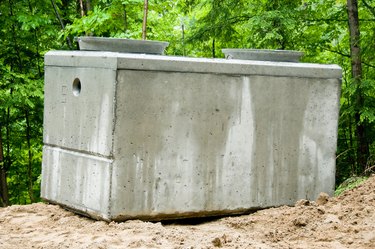
If the waste material exiting your home through the plumbing enters a septic tank rather than a sewer, knowing where the septic system is located is important. Not only will you need to have the system pumped out every three to five years to avoid raw sewage backing up into your pipes, but you want to make sure that you do not park cars, plant trees or pave over any part of the septic tank or drainage field. Doing so could crack the tank or pipes, leaving you to pay for expensive repairs.
Step 1
Examine the ground around your home for areas where the soil is soft. Soft soil that appears only in a certain area of your yard often indicates the presence of a drainage field. A drainage field is the area of ground above your septic tank into which liquid residue from the tank is emptied.
Video of the Day
Step 2
Look for a septic marker. Many homes have septic location markers to help remind homeowners of the location of the septic system. These markers will usually be in the form of a short post or pole in an isolated area of the yard.
Step 3
Examine your yard for any large depressions in the soil. Depressions in the soil that occur in an area clear of trees and other natural land features may indicate the presence of a septic system.
Step 4
Look for any blueprints or property surveys that map out your home and yard. Property surveys often include the exact location of your septic tank and drainage field.
Step 5
Walk around your home's foundation and look for the area where the sewage line exits the home (if you have a basement, you will probably be able to see where the sewer pipe exits the home). If the main sewage line is not visible, check the foundation of your property for any builder's marks that indicate the location of the line. Walk 10 to 15 feet from the area where the sewage line exits your home; most likely, you will be quite near the location of your septic tank.
Step 6
Call a septic service professional. A septic service professional can use a tool such as an electric pipe snake to quickly locate your septic tank and drainage field.
Tip
Clearly mark the location of your tank once you find it so that you can find it again in the future.
If you have a large family, you may wish to have your septic tank pumped more frequently.
Warning
Never attempt to uncover the lid to your septic system or check your tank without the aid of a professional. The gases given off by a septic tank are toxic and can be fatal within minutes.
Video of the Day